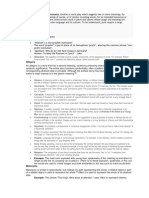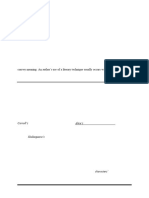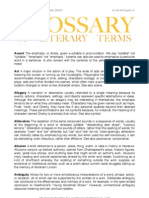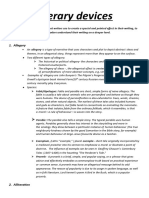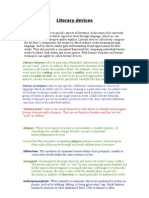0 ratings0% found this document useful (0 votes)
68 viewsLiterature Lecture and Assignment
Literature Lecture and Assignment
Uploaded by
Anonymous wYyVjWTVibThe document discusses various literary devices and figures of speech that writers use to effectively convey ideas and meaning in their works. It provides definitions and examples for over 20 different techniques, including metaphor, simile, personification, irony, symbolism, and more. Literary devices allow authors to add layers of expression and interpretation beyond the literal meaning of words. Understanding these techniques helps readers analyze and appreciate the deeper themes and messages in literature.
Copyright:
© All Rights Reserved
Available Formats
Download as DOCX, PDF, TXT or read online from Scribd
Literature Lecture and Assignment
Literature Lecture and Assignment
Uploaded by
Anonymous wYyVjWTVib0 ratings0% found this document useful (0 votes)
68 views2 pagesThe document discusses various literary devices and figures of speech that writers use to effectively convey ideas and meaning in their works. It provides definitions and examples for over 20 different techniques, including metaphor, simile, personification, irony, symbolism, and more. Literary devices allow authors to add layers of expression and interpretation beyond the literal meaning of words. Understanding these techniques helps readers analyze and appreciate the deeper themes and messages in literature.
Original Title
LITERATURE LECTURE AND ASSIGNMENT.docx
Copyright
© © All Rights Reserved
Available Formats
DOCX, PDF, TXT or read online from Scribd
Share this document
Did you find this document useful?
Is this content inappropriate?
The document discusses various literary devices and figures of speech that writers use to effectively convey ideas and meaning in their works. It provides definitions and examples for over 20 different techniques, including metaphor, simile, personification, irony, symbolism, and more. Literary devices allow authors to add layers of expression and interpretation beyond the literal meaning of words. Understanding these techniques helps readers analyze and appreciate the deeper themes and messages in literature.
Copyright:
© All Rights Reserved
Available Formats
Download as DOCX, PDF, TXT or read online from Scribd
Download as docx, pdf, or txt
0 ratings0% found this document useful (0 votes)
68 views2 pagesLiterature Lecture and Assignment
Literature Lecture and Assignment
Uploaded by
Anonymous wYyVjWTVibThe document discusses various literary devices and figures of speech that writers use to effectively convey ideas and meaning in their works. It provides definitions and examples for over 20 different techniques, including metaphor, simile, personification, irony, symbolism, and more. Literary devices allow authors to add layers of expression and interpretation beyond the literal meaning of words. Understanding these techniques helps readers analyze and appreciate the deeper themes and messages in literature.
Copyright:
© All Rights Reserved
Available Formats
Download as DOCX, PDF, TXT or read online from Scribd
Download as docx, pdf, or txt
You are on page 1of 2
Literature
The medium of literature is language. A poet, fictionist, novelist, dramatist, or essayist,
makes use of words to compose a poem, short story, novel, drama, or essay, respectively. More
often than not, men of letters exploit the suggestive power of language and use words
connotatively. Poets and prose writers make use of idioms, figures of speech, and literary
devices to express their ideas and sentiments regarding a certain subject. Subjects in literature
maybe as ordinary as everyday experiences or extraordinary such as an encounter with aliens,
for example, Martians.
To make writings effective, writers make use of literary devices which include figures of
speech. The following list contain common literary techniques and figure of speech.
Alliteration. The repetition of similar sounds, usually consonants, at the beginning of words. For
example, Robert Frost’s poem “Out, out – contains the alliterative phrase “sweet-scented
stuff”.
Allusion. A reference within a literary work to a historical, literary, mythological, or biblical
character, place, or event. For example, the title of William Faulkner’s novel The Sound and the
Fury alludes to a line from Shakespeare’s Macbeth.
Assonance. The repetition of vowel sounds in a sequence of nearby words. For example, the
line “The monster spoke in a low mellow tone” (from Alfred, Lord Tennyson’s poem “The Lotos-
Eaters”) contains assonance in its repetition of the “o” sound.
Caricature. A description or characterization that exaggerates or distorts a character’s
prominent features, usually for purposes of mockery. For example, a cartoon of a grant
Abraham Lincoln with a giant top hat, a very scraggly beard, and sunken eyes could be
considered a caricature
Cliché. An expression, such as “turn over a new leaf”, that has been used and reused so many
times that it has lost its expressive power.
Foreshadowing. An author’s deliberate use of hints or suggestions to give a preview of events
or themes that do not develop until later in the narrative. Images such as a storm brewing or a
crow landing on a fence post often foreshadow ominous developments in a story.
Hyperbole. An excessive overstatement or conscious exaggeration of fact. “I’ve told you that a
million times already” is a hyperbolic statement.
Idiom. A common expression that has acquired a meaning that differs from its literal meaning
such as “It’s raining cats and dogs” or “that costs me an arm and a leg”.
Imagery. Language that brings to mind sensory impressions. For example, in the Odyssey,
Homer creates a powerful image with his description of “rosy-fingered dawn”.
Irony. Broadly speaking, irony is a device that emphasizes the contrast between the way things
are expected to be and the way the actually are. A historical example of irony might be the fact
that people in medieval Europe believed bathing would harm them when in fact not bathing led
to the unsanitary conditions that caused the bubonic plague.
Metaphor. The comparison of one thing to another hat does not use the terms “like” or “as”. A
metaphor from the Shakespeare’s Macbeth: “Life is buta walking shadow.”
Onomatopoeia. The use of words like pop, hiss, or booing, in which the spoken sound
resembles the actual sound.
Oxymoron. The association of two terms that seem to contradict each other, such as “same
difference” or “wise fool”.
Paradox. A statement that seems contradictory on the surface but often expresses a deeper
truth. One example is the line “All men destroy the things they love” from Oscar Wilde’s “The
Ballad of Reading Gaol”.
Personification. The use of human characteristics to describe to animals, things, or ideas. Carl
Sandburg’s poem “Chicago” describes the city as “Stormy, husky, brawling / City of the Big
Shoulders”.
Pun. A play on words that uses the similarity in sound between two words with distinctly
different meanings. For example, the title of Oscar Wilde’s play “The Importance of Being
Earnest” is a pun on the word earnest, which means serious or sober, and the name “Ernest”.
Rhetorical Question. A question asked not to elicit an actual response but to make an impact or
call attention to something. “Will the world ever see the end of the war?” is an example of a
rhetorical question.
Sarcasm. A form of verbal irony in which it is obvious from context and tone that the speaker
means the opposite of what he or she says. Saying “That was graceful” when someone trips and
falls is an example of sarcasm.
Simile. A comparison of two things through the use of words like or as. The title of Robert
Burns’s poem “My Love Is Like a red, red Rose” is a simile.
Symbol. An object, character, figure, place, or color used to represent an abstract idea or
concept. For example, the two roads in Robert Frost’s poem “The Road Not Taken” symbolize
the choice between two paths in life.
Theme. A fundamental, universal idea explored in a literary work. The struggle to achieve the
American Dream, for example, is a common theme in 20th-century American literature.
Tone. The general atmosphere created in a story, or the author’s or narrator’s attitude toward
the story or the subject. For example, the tone of the Declaration of Independence is
determined and confident.
INDIVIDUAL ACTIVITY: 1 whole yellow paper,
handwritten
Direction: Choose ten (10) figures of speech then give
two (2) examples for each.
NOTE: No work immersion student will be excused. You
may submit your work to your president before your
deployment date.
DATE OF SUBMISSION: MARCH 6, 2019 until 3:00 pm
only
You might also like
- Literary TermsDocument7 pagesLiterary Termssulo444No ratings yet
- List of Fathers of Important Literary GenresDocument23 pagesList of Fathers of Important Literary GenresIce The Human Error100% (2)
- EAPP Concept PaperDocument18 pagesEAPP Concept PaperAnonymous wYyVjWTVib79% (19)
- Literary Devices, Techniques and Figures of SpeechDocument3 pagesLiterary Devices, Techniques and Figures of SpeechJoice Dela cruzNo ratings yet
- Literary Techniques and Figures of SpeechDocument2 pagesLiterary Techniques and Figures of SpeechGarrett McfarlaneNo ratings yet
- Literary Techniques and Figures of SpeechDocument3 pagesLiterary Techniques and Figures of SpeechShai ReenNo ratings yet
- 25 Literary Terms SATsDocument1 page25 Literary Terms SATsmn_mikeNo ratings yet
- Basic Approach To Text AnalysisDocument6 pagesBasic Approach To Text AnalysisMaría Regal CarballoNo ratings yet
- Literary TermsDocument6 pagesLiterary TermsArie RamsNo ratings yet
- Some Definitions of Literary Devices, Techniques and Style From Searching ViaDocument13 pagesSome Definitions of Literary Devices, Techniques and Style From Searching ViaGalina GandraburaNo ratings yet
- Literary DevicesDocument7 pagesLiterary DevicesArgie Ray Ansino ButalidNo ratings yet
- List of Literary and Poetic TermsDocument8 pagesList of Literary and Poetic TermsBelenVetteseNo ratings yet
- Figuri de Stil Pentru EXAMEN!Document3 pagesFiguri de Stil Pentru EXAMEN!Iulianushka AndronicNo ratings yet
- List of Poetic Devices and DefinitionsDocument5 pagesList of Poetic Devices and DefinitionsSeema Syeda100% (1)
- Literary DevicesDocument8 pagesLiterary DevicesAndrew Eugene100% (1)
- Literary DevicesDocument7 pagesLiterary DevicesEmmanuel Absuela Jr.No ratings yet
- Literary Techniques DefinitionsDocument4 pagesLiterary Techniques DefinitionsRayNo ratings yet
- Glossary of Poetic TermsDocument24 pagesGlossary of Poetic Terms2234.arellanes.andreaNo ratings yet
- Literary_DevicesDocument8 pagesLiterary_Devicesyejinha0130No ratings yet
- Content: 1) Definition of Literature 2) Functions of Literature 3) Literary Forms and New Forms 4) Literary TermsDocument6 pagesContent: 1) Definition of Literature 2) Functions of Literature 3) Literary Forms and New Forms 4) Literary TermsYel GragasinNo ratings yet
- Figures of SpeechDocument3 pagesFigures of SpeechJeremiah NayosanNo ratings yet
- Guide To Literary Terms PDFDocument28 pagesGuide To Literary Terms PDFmadwani1No ratings yet
- English A1 NotesDocument31 pagesEnglish A1 Notesleedh0124No ratings yet
- English Technique DefinitionDocument19 pagesEnglish Technique Definitionsandy218maNo ratings yet
- Literary Devices PDFDocument8 pagesLiterary Devices PDFJean Carlos Vicente RiveraNo ratings yet
- 20 PoeticDocument4 pages20 Poeticagenta4773No ratings yet
- Important Terms of LitteratureDocument13 pagesImportant Terms of LitteratureLigia Lopes PinhoNo ratings yet
- Glossary of Literary Terms (Beam Version)Document36 pagesGlossary of Literary Terms (Beam Version)Beam ChansangavejNo ratings yet
- Lesson3 21STCLPWDocument32 pagesLesson3 21STCLPWClaudia SalduaNo ratings yet
- Literary Terms and DevicesDocument6 pagesLiterary Terms and DevicesChristine DeoquinoNo ratings yet
- Literary TermsDocument6 pagesLiterary TermsLee MeiNo ratings yet
- Literary DevicesDocument23 pagesLiterary DevicesMuhammad UsmanNo ratings yet
- Literary Terms: Simone, Bre, and Zac CDocument40 pagesLiterary Terms: Simone, Bre, and Zac Capi-26212993100% (1)
- Notes For 21ST CenturyDocument2 pagesNotes For 21ST CenturyChesca GaribayNo ratings yet
- Figures of Speech PDFDocument14 pagesFigures of Speech PDFGriselda RodríguezNo ratings yet
- Literary Devices: 1. AllegoryDocument10 pagesLiterary Devices: 1. AllegoryAnjali SinghNo ratings yet
- Essential Literary TermsDocument6 pagesEssential Literary TermsSriharsh KasichainulaNo ratings yet
- What Are Literary Devices in FictionDocument12 pagesWhat Are Literary Devices in FictionAnis SafiraNo ratings yet
- Studying PoetryDocument47 pagesStudying PoetryKhalil Abdulhameed100% (1)
- A Glossary of Literary TermsDocument10 pagesA Glossary of Literary Termsmatteoduperou49No ratings yet
- Literary Terms 2024Document68 pagesLiterary Terms 2024diariodevalNo ratings yet
- Creative WritingDocument7 pagesCreative WritingMaureen PusingNo ratings yet
- Literary DevicesDocument16 pagesLiterary DevicessolekeNo ratings yet
- Definitions and Examples of Literary TermsDocument14 pagesDefinitions and Examples of Literary TermsRomina Paola PiñeyroNo ratings yet
- What Are Literary Devices in Fiction 1Document12 pagesWhat Are Literary Devices in Fiction 1Sajjoo KhanNo ratings yet
- Definition of LyricDocument8 pagesDefinition of LyricNikhil IyerNo ratings yet
- Drama: Baccalaureate 2021 Prerequisites (Part 1) Literary Genres All FictionDocument11 pagesDrama: Baccalaureate 2021 Prerequisites (Part 1) Literary Genres All FictionMatildaNo ratings yet
- Literary DevicesDocument34 pagesLiterary DevicesMiaNo ratings yet
- Literature Booklet 2 ND - by MSC - PeterDocument38 pagesLiterature Booklet 2 ND - by MSC - PeterMatias EduardoNo ratings yet
- Literary DevicesDocument8 pagesLiterary Devicescwittesaele_20117686100% (3)
- Glossary of Literary TermsDocument6 pagesGlossary of Literary Termsaakritib_4100% (1)
- HSC English: Literary TechniquesDocument7 pagesHSC English: Literary Techniquesamy_nom100% (1)
- Figures of Speech and Literary DevicesDocument8 pagesFigures of Speech and Literary DevicesTon RJ Ido100% (1)
- Figure of SpeechDocument22 pagesFigure of SpeechCHAUHAN NITINNo ratings yet
- Literary Terms Page 1Document8 pagesLiterary Terms Page 1Taryn BrightNo ratings yet
- Glossary of Terms For English LiteratureDocument4 pagesGlossary of Terms For English Literatureapi-238523254100% (1)
- AP Lit Critical Analysis TermsDocument8 pagesAP Lit Critical Analysis Termsunknown racerx50No ratings yet
- Gale Researcher Guide for: The Epic, Mocked: Alexander Pope's The Rape of the LockFrom EverandGale Researcher Guide for: The Epic, Mocked: Alexander Pope's The Rape of the LockNo ratings yet
- J S PromDocument30 pagesJ S PromAnonymous wYyVjWTVibNo ratings yet
- Concep PaperDocument4 pagesConcep PaperAnonymous wYyVjWTVibNo ratings yet
- Culminating Activity Creative WritingDocument12 pagesCulminating Activity Creative WritingAnonymous wYyVjWTVib100% (1)
- Literay GenresDocument33 pagesLiteray GenresAnonymous wYyVjWTVib100% (1)
- Culminating Activity Creative WritingDocument12 pagesCulminating Activity Creative WritingAnonymous wYyVjWTVib100% (1)
- Principles of Social WorkDocument3 pagesPrinciples of Social WorkAnonymous wYyVjWTVib100% (1)
- San Agustin Diocesan Academy, Inc.: Jaen, Nueva EcijaDocument1 pageSan Agustin Diocesan Academy, Inc.: Jaen, Nueva EcijaAnonymous wYyVjWTVibNo ratings yet
- To Build A FireDocument15 pagesTo Build A FireAnonymous wYyVjWTVib100% (1)
- Nature and Elements of CommunicationDocument2 pagesNature and Elements of CommunicationAnonymous wYyVjWTVibNo ratings yet
- Introduction To Media and Information LiteracyDocument3 pagesIntroduction To Media and Information LiteracyAnonymous wYyVjWTVibNo ratings yet
- Events and Management ServicesDocument9 pagesEvents and Management ServicesAnonymous wYyVjWTVibNo ratings yet
- BriefDocument9 pagesBriefAnonymous wYyVjWTVibNo ratings yet
- Cynel賢人kenDocument34 pagesCynel賢人kenAnonymous wYyVjWTVibNo ratings yet
- Poetry Analysis 10 QuestionsDocument1 pagePoetry Analysis 10 QuestionsAnonymous wYyVjWTVibNo ratings yet
- ParaphrasingDocument4 pagesParaphrasingAnonymous wYyVjWTVibNo ratings yet
- Literary Disaster and LegalismDocument2 pagesLiterary Disaster and LegalismAnonymous wYyVjWTVibNo ratings yet
- Eveline (Summary)Document10 pagesEveline (Summary)Anonymous wYyVjWTVibNo ratings yet
- QuestionnaireDocument8 pagesQuestionnaireMalik AsimNo ratings yet
- CSR 1 Last Check Na SANA TALAGADocument9 pagesCSR 1 Last Check Na SANA TALAGAMaroden Sanchez GarciaNo ratings yet
- The Role of Culture in Verbal and Non-Verbal CommunicationDocument3 pagesThe Role of Culture in Verbal and Non-Verbal CommunicationDuy Nhàn VõNo ratings yet
- China Government 1.1 DocumentsDocument4 pagesChina Government 1.1 DocumentsNatsumeyashiiNo ratings yet
- 01-FREEDOM and MORALITYDocument9 pages01-FREEDOM and MORALITYFredielyn Santos LuyamanNo ratings yet
- Academic Connectors: Vocabulary - AwlDocument3 pagesAcademic Connectors: Vocabulary - AwlDarcy100% (1)
- Practicum Report: Polytechnic University of The Philippines Quezon City CampusDocument6 pagesPracticum Report: Polytechnic University of The Philippines Quezon City CampusRoland IrojoNo ratings yet
- Geography: Assignment 1Document46 pagesGeography: Assignment 1api-295518079No ratings yet
- Mind, Metaphor and Language TeachingDocument257 pagesMind, Metaphor and Language TeachingReem AlNo ratings yet
- RPH BI YEAR 6-Unit 1 (w1-2)Document9 pagesRPH BI YEAR 6-Unit 1 (w1-2)PowerMerch100% (1)
- Taoism: The Basics: Unit 2, Lesson 17Document2 pagesTaoism: The Basics: Unit 2, Lesson 17Anjie LapezNo ratings yet
- Positive Behavior Supports For Students With Moderate To Severe Behavioral ChangesDocument2 pagesPositive Behavior Supports For Students With Moderate To Severe Behavioral ChangesLucky Pimentel CataluñaNo ratings yet
- English Dictionaries As Cultural Mines - Roberta FacchinettiDocument270 pagesEnglish Dictionaries As Cultural Mines - Roberta FacchinettiPenélope MirandaNo ratings yet
- THe Biography of Three 19th Century PDFDocument255 pagesTHe Biography of Three 19th Century PDFIssayas Beyene100% (1)
- Topic 12Document7 pagesTopic 12Teresa Pajarón LacaveNo ratings yet
- Communication For:: JournalistsDocument22 pagesCommunication For:: JournalistsGenesis FernandezNo ratings yet
- Mapping Sub-Saharan Africa's Future: Conference SummaryDocument17 pagesMapping Sub-Saharan Africa's Future: Conference SummaryJoel LawsonNo ratings yet
- Try Out 2 2019Document9 pagesTry Out 2 2019Evans Sii Jr.No ratings yet
- Syncretism What We Believe TextDocument2 pagesSyncretism What We Believe TextTortura ChinaNo ratings yet
- Intro To ConfucianismDocument19 pagesIntro To ConfucianismRia de los Santos100% (1)
- Cristina Almeida - Edhm 414-001 - Lesson Plan-Incorporating Text SetsDocument13 pagesCristina Almeida - Edhm 414-001 - Lesson Plan-Incorporating Text Setsapi-408072479No ratings yet
- Decent WorkDocument104 pagesDecent WorkGopi KrishnaNo ratings yet
- Family: José P. Rizal José Prota Rizal Mercado y Alonso RealondaDocument9 pagesFamily: José P. Rizal José Prota Rizal Mercado y Alonso RealondaLeigh-ann GarroteNo ratings yet
- MultilingualDocument52 pagesMultilingualAngel Jasmine LlevaNo ratings yet
- Objective Proficiency Student's BookDocument1 pageObjective Proficiency Student's BookPaul GalanNo ratings yet
- Sorcerers GuideDocument106 pagesSorcerers Guidehjn71475% (4)
- Political CArtoon or CaricatureDocument20 pagesPolitical CArtoon or CaricatureRoem Montalbo33% (3)
- Africa and Palestine in Antiquity by FinchDocument6 pagesAfrica and Palestine in Antiquity by FinchedwinmasaiNo ratings yet
- Bipan Chandra, 19th C Economy Critique of Colonial EconomyDocument42 pagesBipan Chandra, 19th C Economy Critique of Colonial EconomyNajaf Haider100% (1)
- WRITTEN REPORT - Teaching Children and Adolescent Literary Through Appropriate Books and Strategies in LiteratureDocument9 pagesWRITTEN REPORT - Teaching Children and Adolescent Literary Through Appropriate Books and Strategies in LiteratureIVY YBAÑEZNo ratings yet












